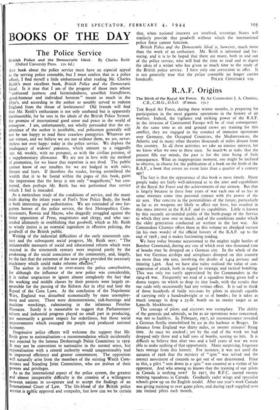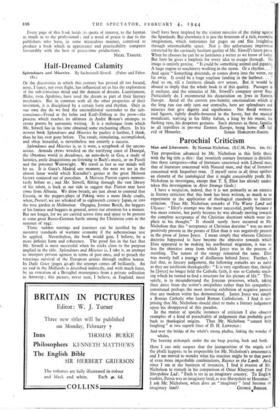R.A.F. Origins
The Birth of the Royal Air Force. By Air Commodore J. A. Chamier, C.B., C.M.G., D.S.O. (Pitman. is.) THE Royal Air Force, during these winter months, is preparing for participation in the most gigantic operations in the history of air warfare. Indeed, the vigilance and striking power of the R.A.F. in the invasion of Continental Europe will be of vital consequence. At the same time as air and ground crews are training for this conflict, they are engaged in the conduct of immense operations over Germany, the Occupied Countries, the Mediterranean, the Atlantic and in many other theatres thousands of miles distant from this country. In all these activities we take an intense interest, for we know what we owe to these men. So much is at stake that the present fills our minds, the past is for the time being of little consequence. What an inappropriate moment, one might be inclined to observe, to choose for the publication of a book on the birth of the R.A.F., a book that covers no event later than a quarter of a century ago!
The fact is that the appearance of this book is most timely. Many people today are fairly well-informed as to the aims and capabilities of the Royal Air Force and the achievements of our airmen. But that is largely because in these four years of war each one of us has in some measure come into personal contact with the power of the air arm. Our concern in the potentialities of the future, particularly so far as air weapons are likely to affect our lives, has resulted in this mass interest in the R.A.F. and its capabilities. Little is known by this recently air-minded public of the birth-pangs of the Service to which they now owe so much, and of the conditions under which the older generation conducted air warfare in the last war. Air Commodore Chamier offers them in this volume an abridged version (in his own words) of the official history of the R.A.F. up to the end of 1918 ' • and it makes fascinating reading. We have today become accustomed to the mighty night battles of Bomber Command, during any one of which over two thousand tons of bombs may be dropped on a German city. In the whole of the last war German airships and aeroplanes drooped on this country no more than 169 tons, involving the deaths of 1,414 persons and injuring 3,416. And we have also today realised the value of concentration of attack, both in regard to strategic and tactical bombing. This was only too rarely appreciated by the Commanders in the 1914-18 war. Frequently we read of a squadron being given half a dozen targets on which to drop its tiny loads, with the results that our raids only occasionally had any serious effect. It is sad to think of those hundreds of futile missions by pilots in aircraft capable of carrying only a hundredweight or so of bombs ; for it takes as much courage to drop a 25-lb. bomb on an enemy target as an 8,000-lb. blockbuster.
The courage of pilots and aircrews was exemplary. The ability of the generals and admirals, so far as air operations were concerned, was not so faultless. In February, 1917, air reconnaissance revealed a German flotilla immobilised by ice in the harbour at Bruges. Its distance from England was thirty miles, or twenty minutes' flying time. At once we atacked • yet by the end of the week we had dropped only three and a half tons of bombs, scoring no hits. It is difficult to believe that after two and a half years of war we were able to make nothing of that opportunity. Many surprising, forgotten facts emerge from this history. For instance, it was not until the autumn of 1916 that the mystery of " spin " was solved and the correct movement of controls to get out of one determined. Prior to this, a pilot "sent down in a spin" was counted as a victim of his opponent. And who among us knows that the training of our pilots in Canada is nothing new? In 1917, the R.F.C. started twenty training squadrons in Canada. Gradually cadet wings and specialist schools grew up on the English model. After one year's work Canada was giving training to over 4,000 pilots, and during 1918 supplied over 20o trained pilots each month.
Every page of this baok holds its quota of interest, to the layman as much as to the professional : and a word of praise is due to the publishers who have, in some miraculous manner, contrived to produce a book which in appearance and practicability compares favourably with the best of peace-time productions.
NIGEL TANGYE.























 Previous page
Previous page